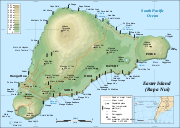
Map coloring
Encyclopedia
Map coloring is the act of assigning different colors to different features on a map. There are two very different uses of this term. The first is in cartography
, choosing the colors to be used when producing a map. The second is in mathematics
, where the problem is to determine the minimum number of colors needed to color a map so that no two adjacent features have the same color.


 Color is a very useful attribute to depict different features on a map. Typical uses of color include displaying different political divisions, different elevations, or different kinds of roads. A choropleth map
Color is a very useful attribute to depict different features on a map. Typical uses of color include displaying different political divisions, different elevations, or different kinds of roads. A choropleth map
is a thematic map in which areas are colored differently to show the measurement of a statistical variable being displayed on the map. The choropleth map provides an easy way to visualize how a measurement varies across a geographic area or it shows the level of variability within a region.
Displaying the data in different hues can greatly affect the understanding or feel of the map. Also, the cartographer must take into account that many people have impaired color vision
, and use colors that are easily distinguishable by these readers.
Colors can also be used to produce three dimensional effects from two dimensional maps, either by explicit color coding of the two images
intended for different eyes, or by using the characteristics of the human visual system to make the map look three dimensional.
, since every map showing different areas has a corresponding graph. By far the most famous result in this area is the four color theorem
, which states that any planar map can be colored with at most four colors.
Cartography
Cartography is the study and practice of making maps. Combining science, aesthetics, and technique, cartography builds on the premise that reality can be modeled in ways that communicate spatial information effectively.The fundamental problems of traditional cartography are to:*Set the map's...
, choosing the colors to be used when producing a map. The second is in mathematics
Mathematics
Mathematics is the study of quantity, space, structure, and change. Mathematicians seek out patterns and formulate new conjectures. Mathematicians resolve the truth or falsity of conjectures by mathematical proofs, which are arguments sufficient to convince other mathematicians of their validity...
, where the problem is to determine the minimum number of colors needed to color a map so that no two adjacent features have the same color.
Cartography



Choropleth map
A choropleth map A choropleth map A choropleth map (Greek χώρος + πληθαίν:, ("area/region" + "multiply") is a thematic map in which areas are shaded or patterned in proportion to the measurement of the statistical variable being displayed on the map, such as population density or per-capita...
is a thematic map in which areas are colored differently to show the measurement of a statistical variable being displayed on the map. The choropleth map provides an easy way to visualize how a measurement varies across a geographic area or it shows the level of variability within a region.
Displaying the data in different hues can greatly affect the understanding or feel of the map. Also, the cartographer must take into account that many people have impaired color vision
Color blindness
Color blindness or color vision deficiency is the inability or decreased ability to see color, or perceive color differences, under lighting conditions when color vision is not normally impaired...
, and use colors that are easily distinguishable by these readers.
Colors can also be used to produce three dimensional effects from two dimensional maps, either by explicit color coding of the two images
Anaglyph image
Anaglyph images are used to provide a stereoscopic 3D effect, when viewed with glasses where the two lenses are different colors, such as red and cyan. Images are made up of two color layers, superimposed, but offset with respect to each other to produce a depth effect...
intended for different eyes, or by using the characteristics of the human visual system to make the map look three dimensional.
Mathematics
In mathematics there is a very strong link between map coloring and graph coloringGraph coloring
In graph theory, graph coloring is a special case of graph labeling; it is an assignment of labels traditionally called "colors" to elements of a graph subject to certain constraints. In its simplest form, it is a way of coloring the vertices of a graph such that no two adjacent vertices share the...
, since every map showing different areas has a corresponding graph. By far the most famous result in this area is the four color theorem
Four color theorem
In mathematics, the four color theorem, or the four color map theorem states that, given any separation of a plane into contiguous regions, producing a figure called a map, no more than four colors are required to color the regions of the map so that no two adjacent regions have the same color...
, which states that any planar map can be colored with at most four colors.

